Physiological and Biochemical Responses of Orange Trees to Different Deficit Irrigation Regimes
Abstract
1. Introduction
2. Results
2.1. Soil Characteristics and Plant Physiological Response to Deficit Irrigation Strategies
2.2. ABA and Proline Detection in Orange Leaves
2.3. The Use of ERT to Identify Soil Drying Pattern under PRD
3. Discussion
4. Materials and Methods
4.1. Experimental Site, Climatic Data, and Crop Water Demands
4.2. ABA and Proline Content Detection in Orange Leaves
4.3. Plant Physiological Indicators and Productive Crop Features
4.4. The Use of Electrical Resistivity Tomography (ERT) to Identify Soil Drying Pattern under PRD
4.5. Statistical Analysis
5. Conclusions
- DI strategies (i.e., RDI and PRD) did not alter soil fertility among treatments and compromise the nutrients uptake by plants;
- The sub-surface drip irrigation (SDI) and the control had similar behaviors, but SDI, allowing the reduction of soil evaporation losses, should be preferable to surface drip irrigation;
- The physiological response to water stress conditions did not show particular differences among the irrigation treatments, not inducing detrimental effects on crop production features;
- Proline accumulation in orange leaves results were not related to water deficit conditions; rather, proline reached the highest values in the well-irrigated T1 and T2 treatments;
- ABA levels in leaves were rather constant in all the treatments, except in T4 (PRD) during September; this response might produce a late adaptive crop production response;
- Prolonged drying cycles during alternate PRD exposed more roots to severe soil drying, thus increasing leaf ABA accumulation.
Author Contributions
Funding
Conflicts of Interest
References
- Robles, J.M.; Botía, P.; Pérez-Pérez, J.G. Subsurface drip irrigation affects trunk diameter fluctuations in lemon trees, in comparison with surface drip irrigation. Agric. Water Manag. 2016, 165, 11–21. [Google Scholar] [CrossRef]
- Girona, J. Regulated deficit irrigation in peach. A global analysis. Acta Hortic. 2002, 592, 335–342. [Google Scholar] [CrossRef]
- Carr, M.K.V. The water relations and irrigation requirements of citrus (Citrus spp.): A review. Exp. Agric. 2012, 48, 347–377. [Google Scholar] [CrossRef]
- Ruíz-Sánchez, M.C.; Domingo, R.; Castel, J.R. Deficit irrigation in fruit trees and vines in Spain. Span. J. Agric. Res. 2010, 8, S5–S20. [Google Scholar] [CrossRef]
- García-Tejero, I.; Durán-Zuazo, V.H.; Muriel-Fernández, J.L.; Jiménez-Bocanegra, J.A. Linking canopy temperature and trunk diameter fluctuations with other physiological water status tools for water stress management in citrus orchards. Funct. Plant Biol. 2011, 38, 106–117. [Google Scholar] [CrossRef]
- Consoli, S.; Stagno, F.; Roccuzzo, G.; Cirelli, G.L.; Intrigliolo, F. Sustainable management of limited water resources in a young orange orchard. Agric. Water Manag. 2014, 132, 60–68. [Google Scholar] [CrossRef]
- Consoli, S.; Stagno, F.; Vanella, D.; Boaga, J.; Cassiani, G.; Roccuzzo, G. Partial root-zone drying irrigation in orange orchards: Effects on water use and crop production characteristics. Eur. J. Agron. 2017, 82, 190–202. [Google Scholar] [CrossRef]
- Pérez-Pérez, J.G.; Navarro, J.M.; Robles, J.M.; Dodd, I.C. Prolonged drying cycles stimulate ABA accumulation in Citrus macrophylla seedlings exposed to partial rootzone drying. Agric. Water Manag. 2018, 210, 271–278. [Google Scholar] [CrossRef]
- Bartels, D.; Sunkar, R. Drought and salt tolerance in plants. Crit. Rev. Plant Sci. 2005, 24, 23–58. [Google Scholar] [CrossRef]
- Moustakas, M.; Sperdouli, I.; Kouna, T.; Antonopoulou, C.I.; Therios, I. Exogenous proline induces soluble sugar accumulation and alleviates drought stress effects on photosystem II functioning of Arabidopsis thaliana leaves. Plant Growth Regul. 2011, 65, 315–325. [Google Scholar] [CrossRef]
- Zaher-Ara, T.; Boroomand, N.; Sadat-Hosseini, M. Physiological and morphological response to drought stress in seedlings of ten citrus. Trees 2016, 30, 985–993. [Google Scholar] [CrossRef]
- Hong, Z.; Lakkineni, K.; Zhang, Z.; Verma, D.P.S. Removal of feedback inhibition of Δ1-pyrroline-5-carboxylate synthetase results in increased proline accumulation and protection of plants from osmotic stress. Plant Physiol. 2000, 122, 1129–1136. [Google Scholar] [CrossRef] [PubMed]
- Deuschle, K.; Funck, D.; Hellmann, H.; Daschner, K.; Binder, S.; Frommer, W.B. A nuclear gene encoding mitochondrial Δ1-pyrroline-5-carboxylate dehydrogenase and its potential role in protection from proline toxicity. Plant J. 2001, 27, 345–356. [Google Scholar] [CrossRef] [PubMed]
- Zandalinas, S.I.; Rivero, R.M.; Martínez, V.; Gómez-Cadenas, A.; Arbona, V. Tolerance of citrus plants to the combination of high temperatures and drought is associated to the increase in transpiration modulated by a reduction in abscisic acid levels. BMC Plant Biol. 2016, 16, 105. [Google Scholar] [CrossRef] [PubMed]
- Hussain, S.; Khalid, M.F.; Saqib, M.; Ahmad, S.; Zafar, W.; Rao, M.J.; Morillon, R.; Anjum, M.A. Drought tolerance in citrus rootstocks is associated with better antioxidant defense mechanism. Acta Physiol. Plant. 2018, 40, 135. [Google Scholar] [CrossRef]
- Stagno, F.; Intrigliolo, F.; Consoli, S.; Continella, A.; Roccuzzo, G. Response of orange trees to deficit irrigation strategies: Effects on plant nutrition, yield, and fruit quality. J. Irrig. Drain. Eng. 2015, 141, 04015014. [Google Scholar] [CrossRef]
- Farooq, M.; Wahid, A.; Kobayashi, N.; Fujita, D.; Basra, S.M.A. Plant drought stress: Effects, mechanisms and management. In Sustainable Agriculture; Springer: Dordrecht, The Netherlands, 2009; pp. 153–188. [Google Scholar]
- Stevenson, F.J. Humus Chemistry: Genesis, Composition, Reactions; John Wiley & Sons: Hoboken, NJ, USA, 1994. [Google Scholar]
- Austin, A.T.; Yahdjian, L.; Stark, J.M.; Belnap, J.; Porporato, A.; Norton, U.; Ravetta, D.A.; Schaeffer, S.M. Water pulses and biogeochemical cycles in arid and semiarid ecosystems. Oecologia 2004, 141, 221–235. [Google Scholar] [CrossRef]
- Borken, W.; Matzner, E. Reappraisal of drying and wetting effects on C and N mineralization and fluxes in soils. Glob. Change Biol. 2009, 15, 808–824. [Google Scholar] [CrossRef]
- Ortuño, M.F.; García-Orellana, Y.; Conejero, W.; Ruiz-Sánchez, M.C.; Alarcón, J.J.; Torrecillas, A. Stem and leaf water potentials, gas exchange, sap flow and trunk diameter fluctuations for detecting water stress in lemon trees. Trees 2006, 20, 1–8. [Google Scholar] [CrossRef]
- Capra, A.; Consoli, S.; Russo, A.; Scicolone, B. Integrated agro-economic approach to deficit irrigation on lettuce crops in Sicily (Italy). J. Irrig. Drain. Eng. 2008, 134, 437–445. [Google Scholar] [CrossRef]
- Damour, G.; Simonneau, T.; Cochard, H.; Urban, L. An overview of models of stomatal conductance at the leaf level. Plant Cell Environ. 2010, 33, 1419–1438. [Google Scholar] [CrossRef] [PubMed]
- Xu, Z.; Zhou, G. Responses of leaf stomatal density to water status and its relationship with photosynthesis in a grass. J. Exp. Bot. 2008, 59, 3317–3325. [Google Scholar] [CrossRef] [PubMed]
- Ahmad, P.; Rasool, S.; Gul, A.; Sheikh, S.A.; Akram, N.A.; Ashraf, M.; Kazi, A.M.; Gucel, S. Jasmonates: Multifunctional Roles in Stress Tolerance. J. Front. Plant Sci. 2016, 7, 813. [Google Scholar] [CrossRef] [PubMed]
- Steppe, K.; Dzikiti, S.; Lemeur, R.; Milford, J.R. Stomatal oscillations in orange trees under natural climatic conditions. Ann. Bot. 2006, 97, 831–835. [Google Scholar] [CrossRef]
- Hanson, A.D.; Rathinasabapathi, B.; Rivoal, J.; Burnet, M.; Dillon, M.O.; Gage, D.A. Osmoprotective compounds in the Plumbaginaceae: A natural experiment in metabolic engineering of stress tolerance. Proc. Natl. Acad. Sci. USA 1994, 91, 306–310. [Google Scholar] [CrossRef]
- Ben Hassine, A.; Ghanem, M.E.; Bouzid, S.; Lutts, S. An inland and a coastal population of the Mediterranean xerohalophyte species Atriplex halimus L. differ in their ability to accumulate proline and glycine betaine in response to salinity and water stress. J. Exp. Bot. 2008, 59, 1315–1326. [Google Scholar] [CrossRef]
- Parida, A.K.; Dagaonkar, V.S.; Phalak, M.S.; Aurangabadkar, L.P. Differential responses of the enzymes involved in proline biosynthesis and degradation in drought tolerant and sensitive cotton genotypes during drought stress and recovery. Acta Physiol. Plant. 2008, 30, 619–627. [Google Scholar] [CrossRef]
- Hayano-Kanashiro, C.; Calderon-Vazquez, C.; Ibarra-Laclette, E.; Herrera-Estrella, L.; Simpson, J. Analysis of gene expression and physiological responses in three mexican maize landraces under drought stress and recovery irrigation. PLoS ONE 2009, 4, e7531. [Google Scholar] [CrossRef]
- Mattioli, R.; Costantino, P.; Trovato, M. Proline accumulation in plants. Not only stress. Plant Signal. Behav. 2009, 4, 1016–1018. [Google Scholar] [CrossRef]
- Chiang, H.H.; Dandekar, A.M. Regulation of proline accumulation in Arabidopsis during development and in response to dessication. Plant Cell Environ. 1995, 18, 1280–1290. [Google Scholar] [CrossRef]
- Schwacke, R.; Grallath, S.; Breitkreuz, K.E.; Stransky, H.; Frommer, W.B.; Rentsch, D. LeProT1, a transporter for proline, glycine betaine and γ-amino butyric acid in tomato pollen. Plant Cell 1999, 11, 377–391. [Google Scholar] [PubMed]
- Finkelstein, R. Abscisic acid synthesis and response. In The Arabidopsis Book; American Society of Plant Biologists: Rockville, MR, USA, 2013; p. 111. [Google Scholar]
- Hartung, A.; Sauter, E. Hose Abscisic acid in the xylem: Where does it come from, where does it go? J. Exp. Bot. 2002, 53, 27–32. [Google Scholar] [CrossRef] [PubMed]
- Romero, P.; Lafuente, M.T.; Rodrigo, M.J. The Citrus ABA signalosome: Identification and transcriptional regulation during sweet orange fruit ripening and leaf dehydration. J. Exp. Bot. 2012, 63, 695–709. [Google Scholar] [CrossRef] [PubMed]
- Puértolas, J.; Conesa, M.R.; Ballester, C.; Dodd, I.C. Local root abscisic acid (ABA) accumulation depends on the spatial distribution of soil moisture in potato: Implications for ABA signalling under heterogeneous soil drying. J. Exp. Bot. 2014, 66, 2325–2334. [Google Scholar] [CrossRef]
- Dodd, I.C.; Egea, G.; Davies, W.J. Abscisic acid signalling when soil moisture is heterogeneous: Decreased photoperiod sap flow from drying roots limits abscisic acid export to the shoots. Plant Cell Environ. 2008, 31, 1263–1274. [Google Scholar] [CrossRef]
- Pérez-Pérez, J.G.; Dodd, I.C. Sap fluxes from different parts of the rootzone modulate xylem ABA concentration during partial rootzone drying and re-wetting. J. Exp. Bot. 2015, 66, 2315–2324. [Google Scholar] [CrossRef]
- Allen, R.G.; Pereira, L.S.; Raes, D.; Smith, M. Crop Evapotranspiration. Guidelines for Computing Crop Water Requirements; Irrigation and Drainage Paper No, 56; FAO: Rome, Italy, 1998; p. 300. [Google Scholar]
- Allen, R.G.; Pruitt, W.O.; Wright, J.L.; Howell, T.H.; Ventura, F.; Snyder, R.; Itenfisu, D.; Steduto, P.; Berengena, J.; Baselga Yrisarry, J.; et al. A recommendation on standardized surface resistance for hourly calculation of reference ETo by the FAO56Penman-Monteith method. Agric. Water Manag. 2006, 81, 1–22. [Google Scholar] [CrossRef]
- Consoli, S.; O’Connell, N.; Snyder, R. Estimation of evapotranspiration of different-sized navel-orange tree orchards using energy balance. J. Irrig. Drain. Eng. 2006, 132, 2–8. [Google Scholar] [CrossRef]
- Consoli, S.; Papa, R. Corrected surface energy balance to measure and model the evapotranspiration of irrigated orange orchards in semi-arid Mediterranean conditions. Irrig. Sci. 2013, 31, 1159–1171. [Google Scholar] [CrossRef]
- Swanson, R.H.; Whitfield, D.W.A. A numerical analysis of heat pulse velocity theory and practice. J. Exp. Bot. 1981, 32, 221–239. [Google Scholar] [CrossRef]
- Green, S.R.; Clothier, B.; Jardine, B. Theory and practical application of heat pulse to measure sap flow. Agron. J. 2003, 95, 1371–1379. [Google Scholar] [CrossRef]
- Aiello, R.; Bagarello, V.; Barbagallo, S.; Consoli, S.; Di Prima, S.; Giordano, G.; Iovino, M. An assessment of the Beerkan method for determining the hydraulic properties of a sandy loam soil. Geoderma 2014, 235, 300–307. [Google Scholar] [CrossRef]
- D’Emilio, A.; Aiello, R.; Consoli, S.; Vanella, D.; Iovino, M. Artificial Neural Networks for Predicting the Water Retention Curve of Sicilian Agricultural Soils. Water 2018, 10, 1431. [Google Scholar] [CrossRef]
- Page, A.L.; Miller, R.H.; Keeney, D.R. Methods of Soil Analysis. Part 2. Chemical and Microbial Properties; American Society of Agronomy No. 9 (Part 2) in the Agronomy Series; ASA/SSSA: Madison, WI, USA, 1982. [Google Scholar]
- Hubick, K.T.; Reid, D.M. A rapid method for the extraction and analysis of abscisic acid from plant tissue. Plant Physiol. 1980, 65, 523–525. [Google Scholar] [CrossRef] [PubMed]
- Bates, L.S.; Waldren, R.P.; Teare, I.D. Rapid determination of free proline for water-stress studies. Plant Soil 1973, 39, 205–207. [Google Scholar] [CrossRef]
- Khedr, A.H.; Abbas, M.A.; Wahid, A.A.; Quick, W.P.; Abogadallah, G.M. Proline induces the expression of salt-stress responsive proteins and may improve the adaptation of Pancratium maritimum L. to salt-stress. J. Exp. Bot. 2003, 54, 2553–2562. [Google Scholar] [CrossRef] [PubMed]
- Scholander, P.F.; Bradstreet, E.D.; Hemmingsen, E.A.; Hammel, H.T. Sap pressure in vascular plants: Negative hydrostatic pressure can be measured in plants. Science 1965, 148, 339–346. [Google Scholar] [CrossRef]
- Turner, N.C. Techniques and experimental approaches for the measurement of plant water status. Plant Soil 1981, 58, 339–366. [Google Scholar] [CrossRef]
- Radoglou, K.M.; Jarvis, P.G. Effects of CO2 enrichment on four poplar clones. II. Leaf surface properties. Ann. Bot. 1990, 65, 627–632. [Google Scholar] [CrossRef]
- Binley, A.; Hubbard, S.S.; Huisman, J.A.; Revil, A.; Robinson, D.A.; Singha, K.; Slater, L.D. The emergence of hydrogeophysics for improved understanding of subsurface processes over multiple scales. Water Resour. Res. 2015, 51, 3837–3866. [Google Scholar] [CrossRef]
- Vanella, D.; Cassiani, G.; Busato, L.; Boaga, J.; Barbagallo, S.; Binley, A.; Consoli, S. Use of small scale electrical resistivity tomography to identify soil-root interactions during deficit irrigation. J. Hydrol. 2018, 556, 310–324. [Google Scholar] [CrossRef]
- Vanella, D.; Ramírez-Cuesta, J.M.; Intrigliolo, D.S.; Consoli, S. Combining Electrical Resistivity Tomography and Satellite Images for Improving Evapotranspiration Estimates of Citrus Orchards. Remote Sens. 2019, 11, 373. [Google Scholar] [CrossRef]
- Binley, A. R3t Software Version 1.8 March 2013. Available online: http://www.es.lancs.ac.uk/people/amb/Freeware/R3t/R3t.htm (accessed on 17 October 2019).


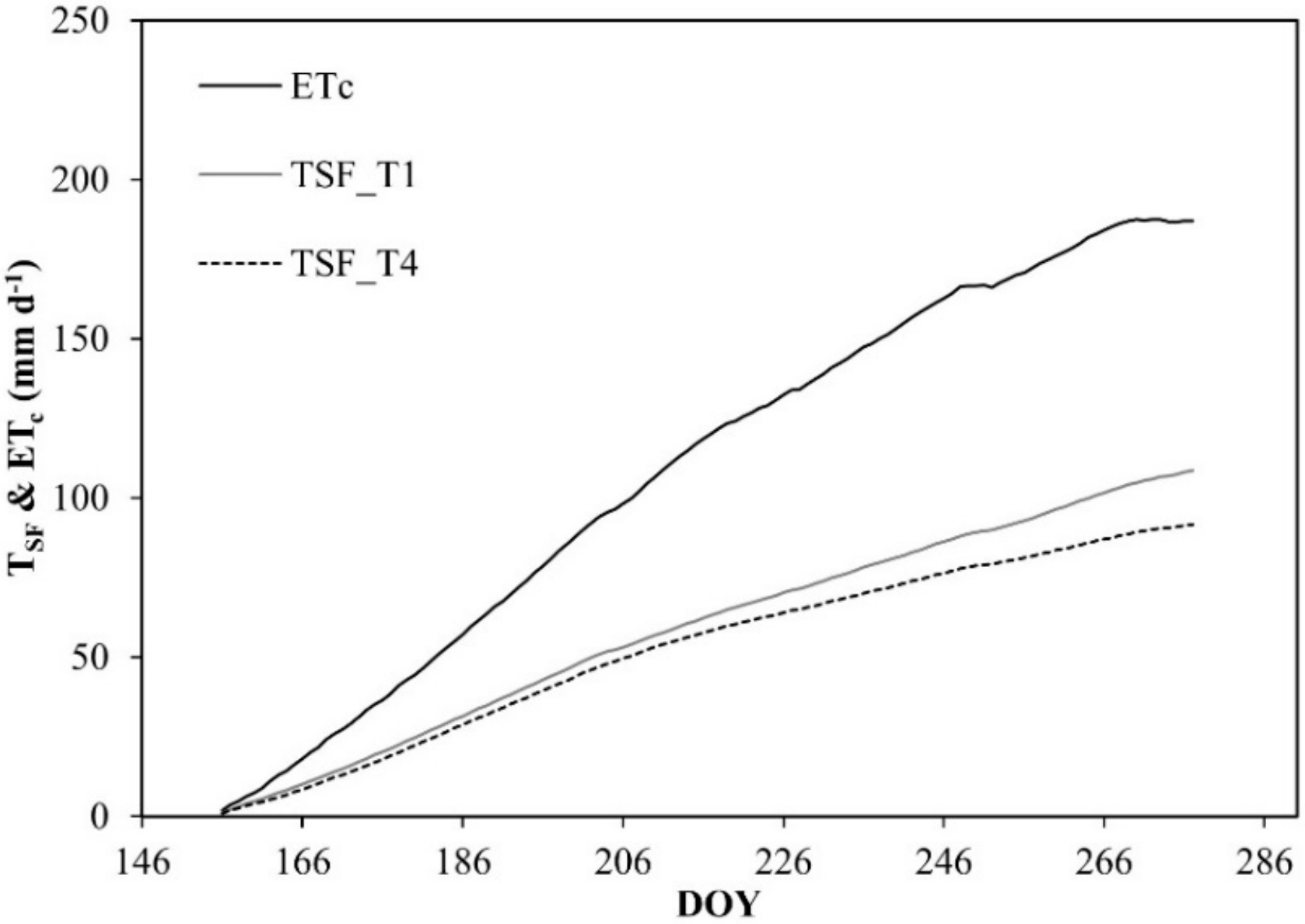
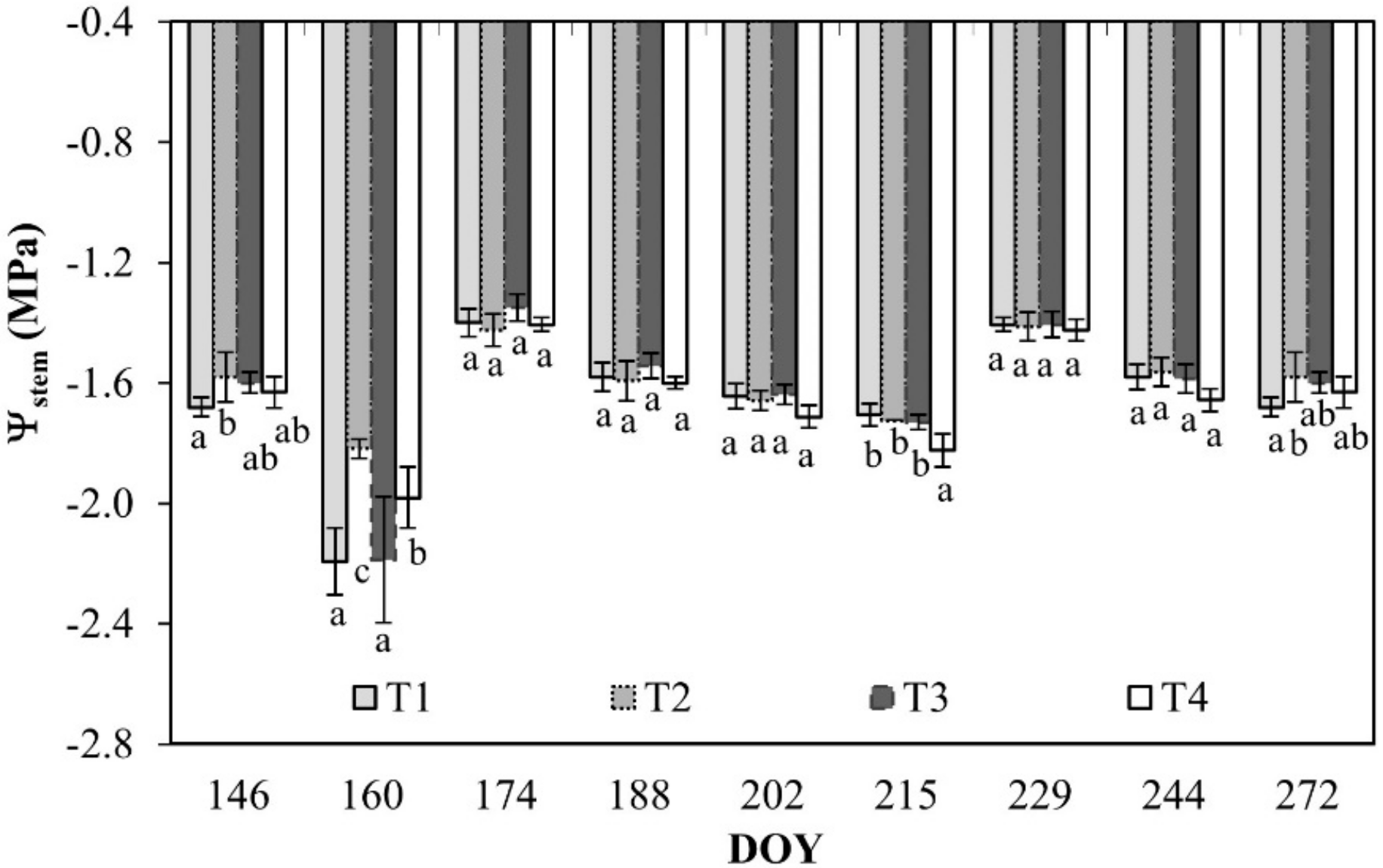
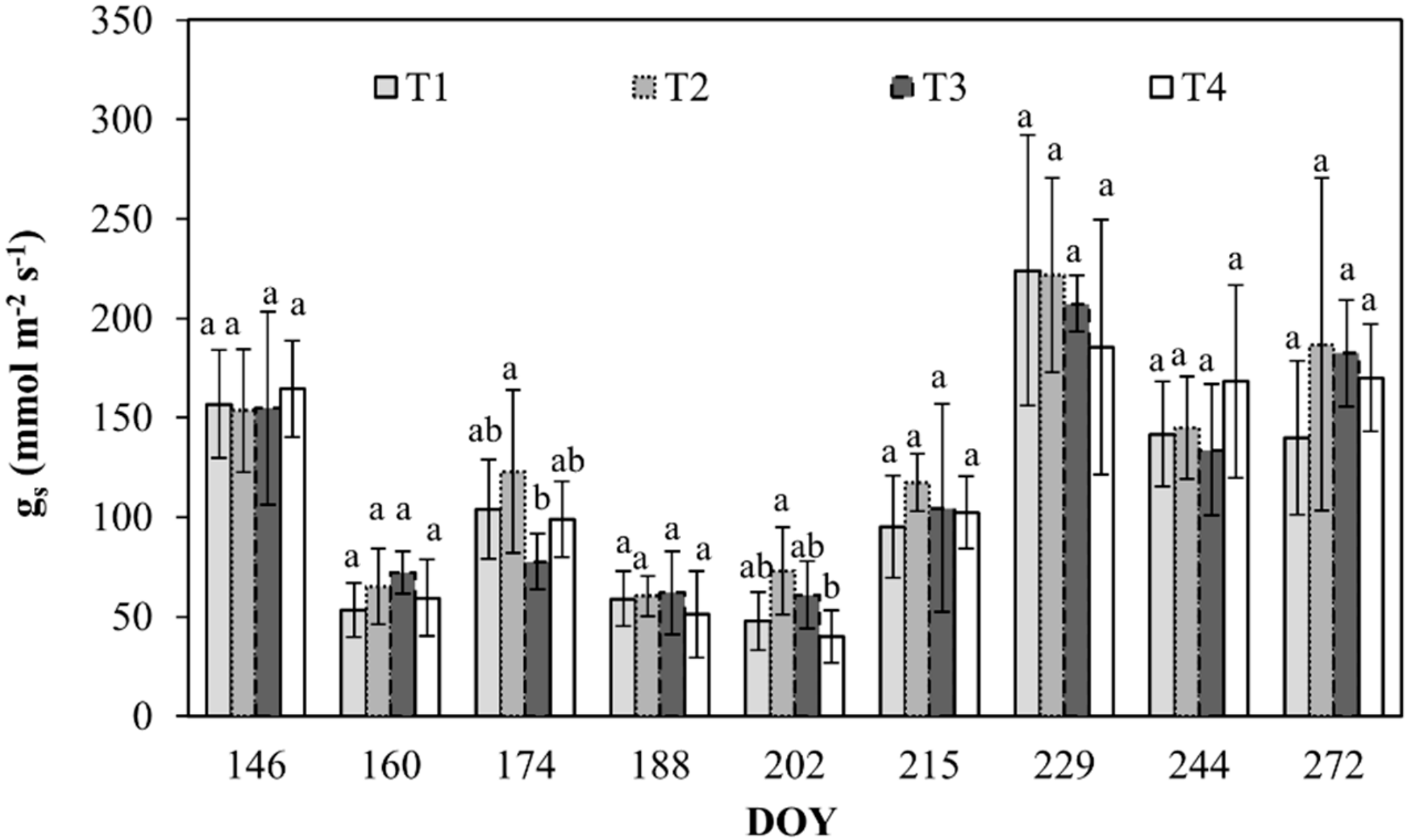

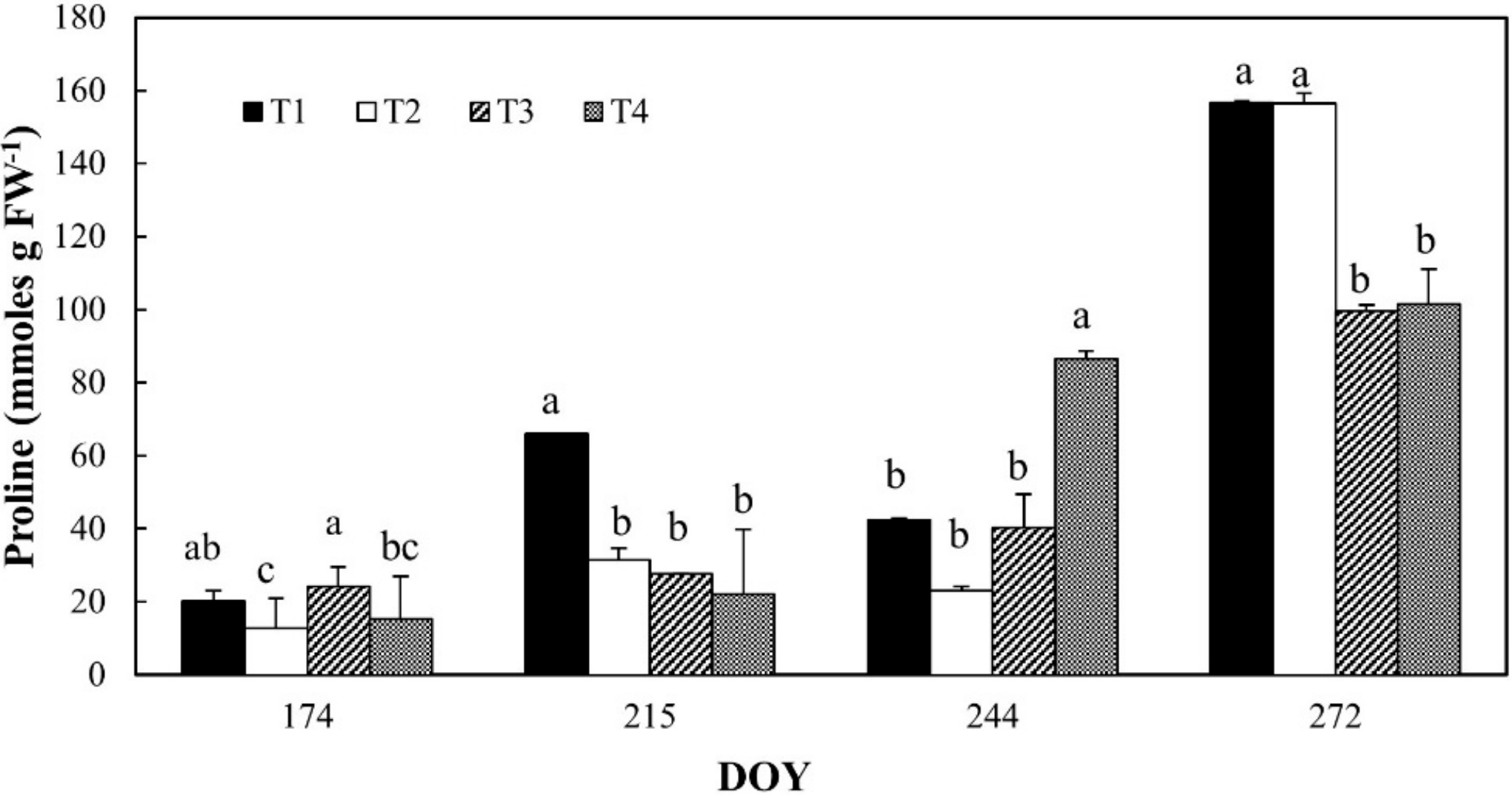
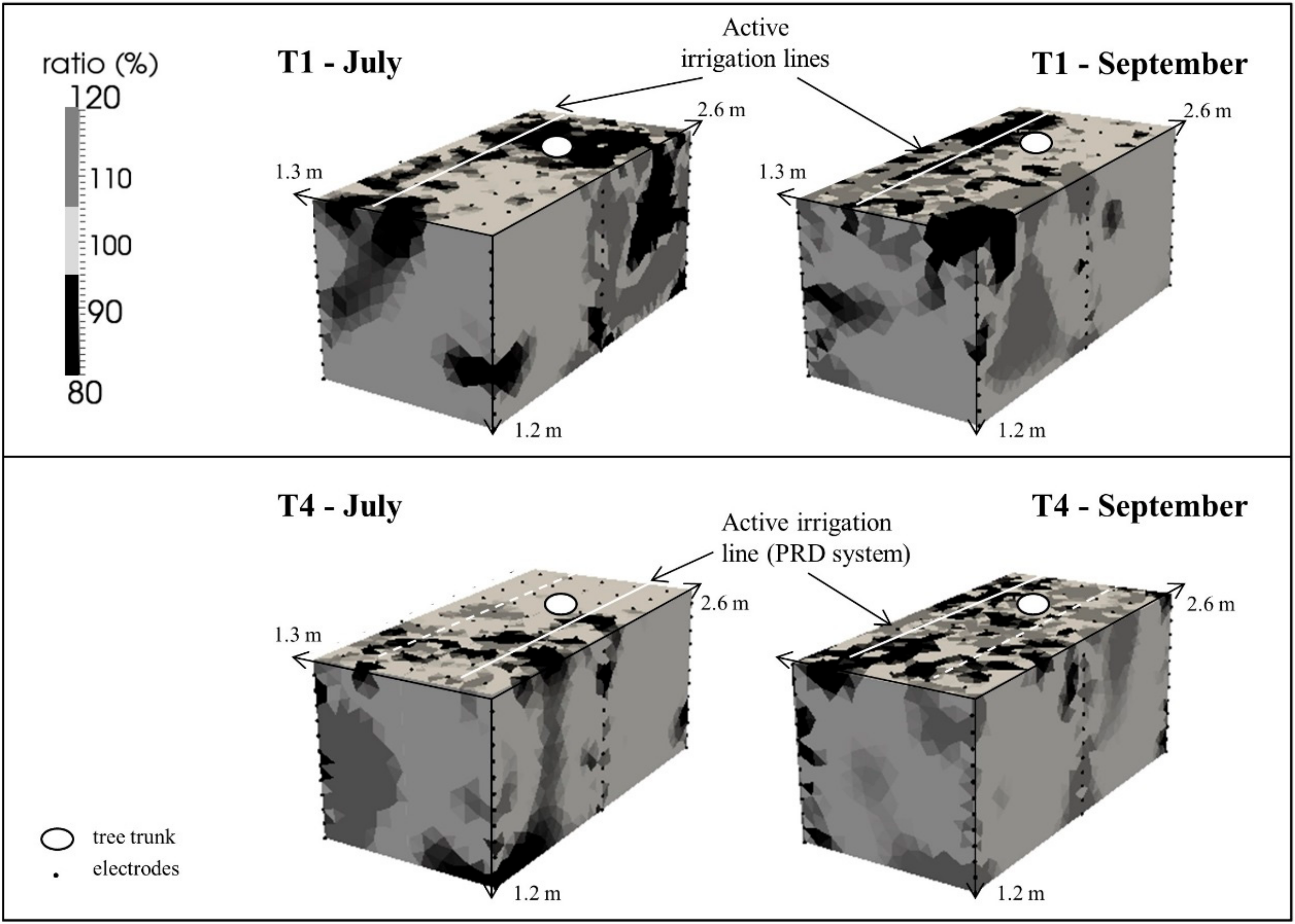
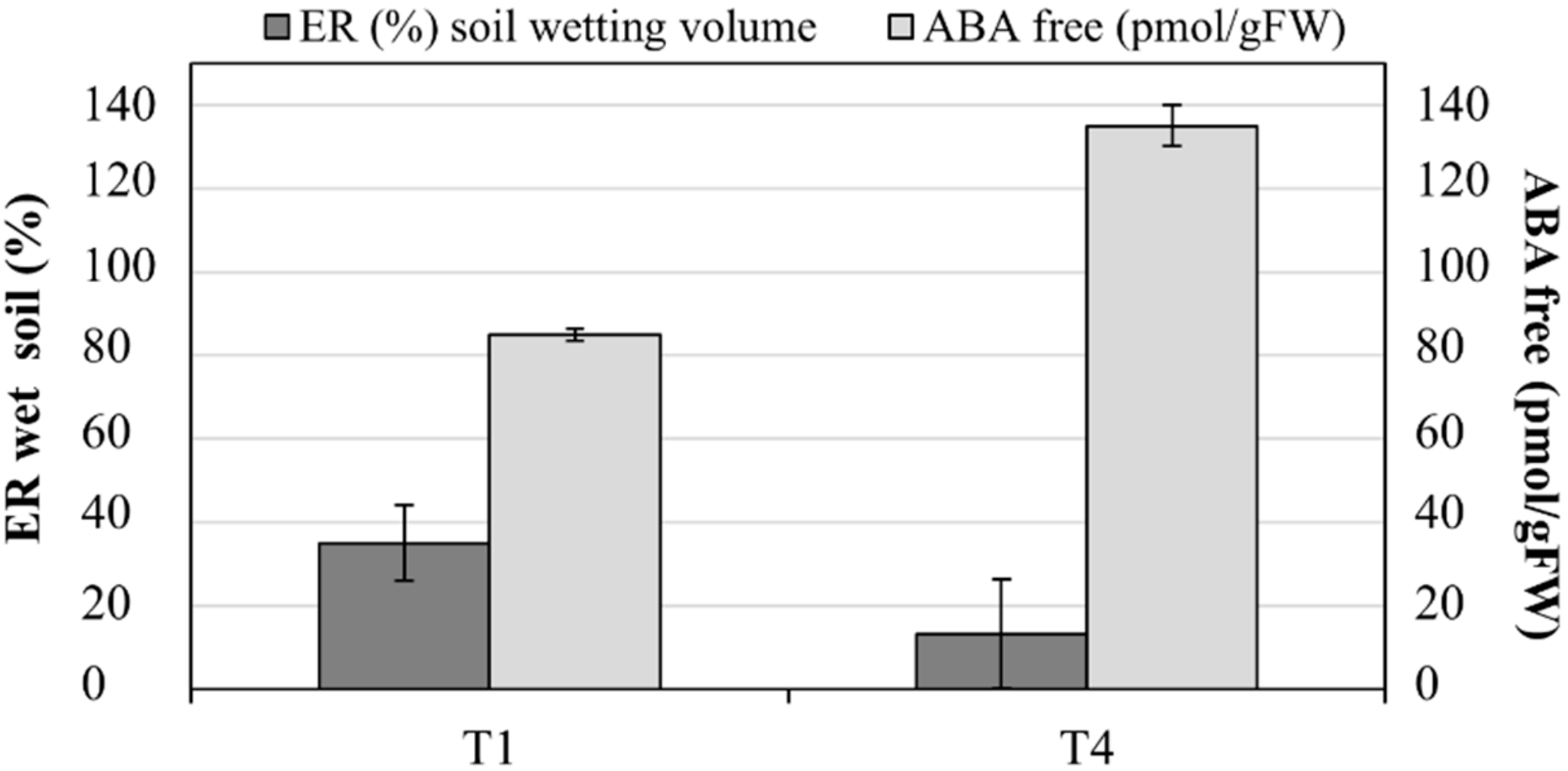
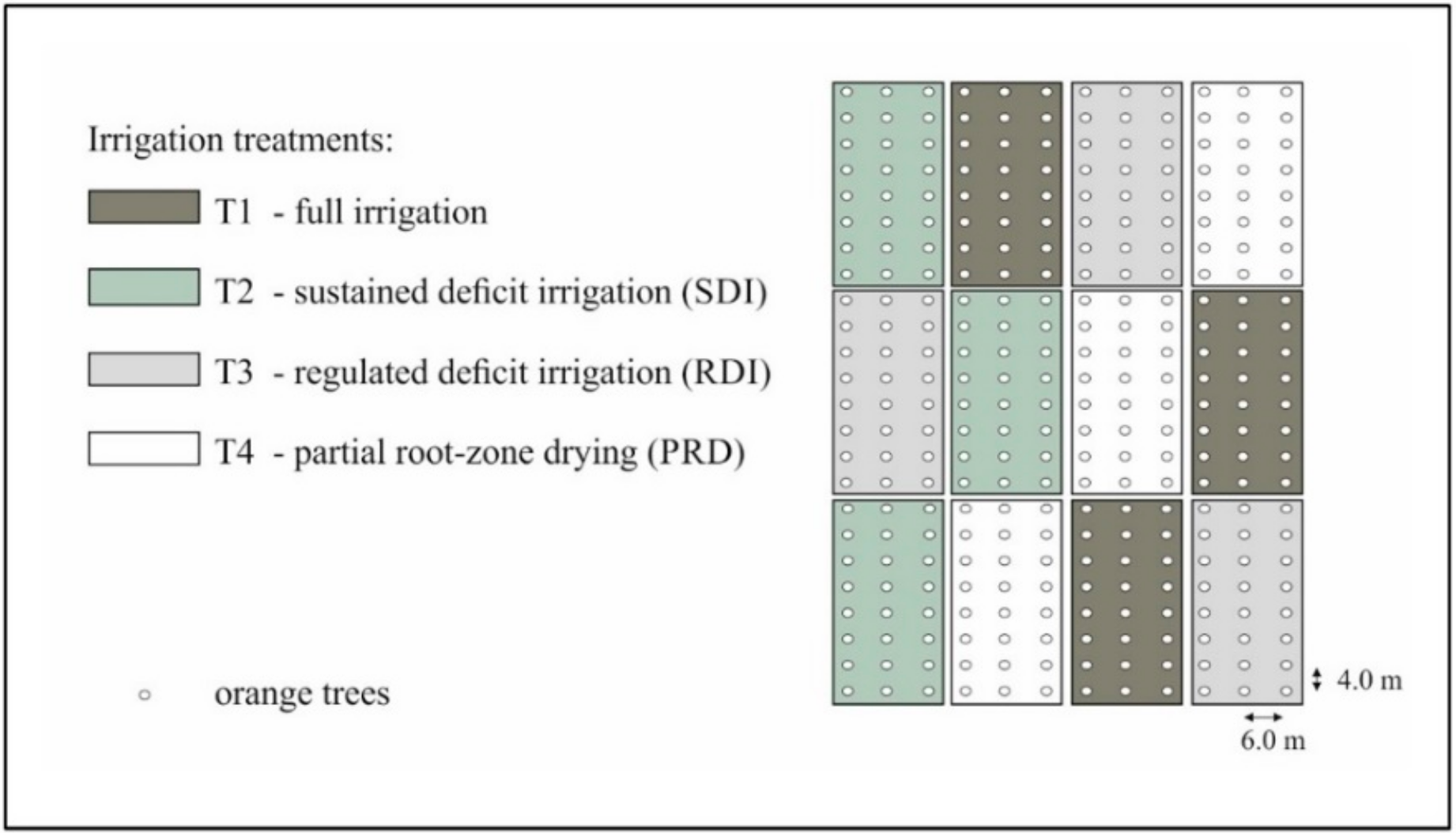
| T1 | T2 | T3 | T4 | |
|---|---|---|---|---|
| Irrigation Rates (mm) | 279.0 | 204.2 | 174.2 | 158.0 |
| Water Savings * (%) | -- | 26.8 | 37.6 | 43.4 |
| Treat. | OC (g kg−1) | NTOT (g kg−1) | CEC (meq 100 g−1) | Ca (g kg−1) | Mg (g kg−1) | K (g kg−1) | Na (g kg−1) | Pavail (mg kg−1) | EC (mS cm−1) | pH |
|---|---|---|---|---|---|---|---|---|---|---|
| T1 | 10.8 a | 0.6 b | 48.9 a | 5.2 b | 2.9 a | 1.2 b | 1.8 a | 56.0 a | 0.32 a | 8.1 a |
| T2 | 10.3 a | 0.3 c | 43.3 a | 7.8 a | 1.7 b | 1.0 b | 0.9 b | 42.9 ab | 0.26 a | 8.3 a |
| T3 | 12.7 a | 1.6 a | 46.1 a | 5.8 b | 2.1 ab | 1.9 a | 1.3 b | 44.9 ab | 0.27 a | 8.3 a |
| T4 | 8.8 b | 0.8 b | 40.0 a | 4.9 b | 2.7 ab | 1.9 a | 1.6 a | 39.9 b | 0.25 a | 8.5 a |
| DOY | Treatment | Fresh Weight (g/leaf) | Dry Weight (g/leaf) | Total Stomata (number/m2) | Opened Stomata (%) | LAI (m2 m−2) | PAR (%) |
|---|---|---|---|---|---|---|---|
| 174 | T1 | 0.8 ± 0.2 b | 0.3 ± 0.1 b | 372.3 ± 52.2 | 66.6 | 4.7 ± 0.9 | 71.5 ± 4.6 |
| T2 | 1.1 ± 0.3 a | 0.4 ± 0.1 a | 369.3 ± 51.0 | 77.9 | 5.2 ± 0.3 | 75.2 ± 2.8 | |
| T3 | 0.9 ± 0.2 ab | 0.3 ± 0.1 ab | 358.9 ± 60.8 | 68.5 | 5.5 ± 0.8 | 75.3 ± 2.0 | |
| T4 | 0.9 ± 0.3 ab | 0.3 ± 0.1 ab | 382.4 ± 51.2 | 69.9 | 5.0 ± 0.7 | 73.4 ± 3.6 | |
| 215 | T1 | 1.1 ± 0.3 | 0.4 ± 0.1 | 328.8 ± 51.0 | 36.6 | 4.0 ± 0.6 | 69.5 ± 6.3 |
| T2 | 1.8 ± 0.4 | 0.4 ± 0.2 | 294.6 ± 77.9 | 31.1 | 4.3 ± 0.3 | 74.8 ± 1.7 | |
| T3 | 1.1 ± 0.2 | 0.4 ± 0.1 | 320.1 ± 90.1 | 39.7 | 4.5 ± 0.7 | 79.1 ± 7.1 | |
| T4 | 1.2 ± 0.2 | 0.5 ± 0.1 | 344.4 ± 61.1 | 38.9 | 4.9 ± 0.3 | 80.4 ± 13.3 | |
| 244 | T1 | 1.2 ± 0.4 | 0.4 ± 0.14 | 279.0 ± 50.8 ab | 36.8 | 3.4 ± 0.5 | 69.1 ± 8.2 |
| T2 | 1.1 ± 0.3 | 0.4 ± 0.14 | 260.5 ± 54.0 b | 24.8 | 4.1 ± 0.6 | 74.7 ± 1.3 | |
| T3 | 1.1 ± 0.3 | 0.4 ± 0.10 | 324.3 ± 53.4 a | 35.9 | 3.3 ± 0.7 | 70 ± 3.8 | |
| T4 | 1.1 ± 0.2 | 0.4 ± 0.11 | 333.0 ± 56.9 a | 27.8 | 3.6 ± 0.7 | 69.3 ± 9.6 | |
| 272 | T1 | 1.6 ± 0.3 a | 0.6 ± 0.1 a | 356.6 ± 39.4 ab | 61.5 | 2.2 ± 0.3 | 44.7 ± 9.6 |
| T2 | 1.2 ± 0.2 b | 0.5 ± 0.1 b | 354.6 ± 48.5 b | 75.5 | 2.6 ± 0.9 | 54.4 ± 12.2 | |
| T3 | 0.9 ± 0.2 b | 0.4 ± 0.1 b | 405.9 ± 70.7 a | 56.5 | 2.4 ± 0.3 | 53.7 ± 11.3 | |
| T4 | 0.9 ± 0.2 b | 0.4 ± 0.1 b | 397.8 ± 78.8 ab | 63.1 | 2.0 ± 0.5 | 43.3 ± 6.5 |
| Treatment | Mean Fruit Weight (g) | Total Yield (t ha−1) | Equatorial Section (ED mm) |
|---|---|---|---|
| T1 | 259.3 ( ± 7.6) | 24.6 ( ± 1.78) | 77.3 ( ± 0.78) |
| T2 | 264.8 ( ± 11.1) | 22.7 ( ± 1.38) | 78.7 ( ± 1.46) |
| T3 | 276.0 ( ± 10.4) | 23.5 ( ± 2.48) | 79.2 ( ± 1.09) |
| T4 | 253.0 ( ± 12.0) | 24.7 ( ± 3.8) | 77.6 ( ± 1.30) |
© 2019 by the authors. Licensee MDPI, Basel, Switzerland. This article is an open access article distributed under the terms and conditions of the Creative Commons Attribution (CC BY) license (http://creativecommons.org/licenses/by/4.0/).
Share and Cite
Puglisi, I.; Nicolosi, E.; Vanella, D.; Lo Piero, A.R.; Stagno, F.; Saitta, D.; Roccuzzo, G.; Consoli, S.; Baglieri, A. Physiological and Biochemical Responses of Orange Trees to Different Deficit Irrigation Regimes. Plants 2019, 8, 423. https://doi.org/10.3390/plants8100423
Puglisi I, Nicolosi E, Vanella D, Lo Piero AR, Stagno F, Saitta D, Roccuzzo G, Consoli S, Baglieri A. Physiological and Biochemical Responses of Orange Trees to Different Deficit Irrigation Regimes. Plants. 2019; 8(10):423. https://doi.org/10.3390/plants8100423
Chicago/Turabian StylePuglisi, Ivana, Elisabetta Nicolosi, Daniela Vanella, Angela Roberta Lo Piero, Fiorella Stagno, Daniela Saitta, Giancarlo Roccuzzo, Simona Consoli, and Andrea Baglieri. 2019. "Physiological and Biochemical Responses of Orange Trees to Different Deficit Irrigation Regimes" Plants 8, no. 10: 423. https://doi.org/10.3390/plants8100423
APA StylePuglisi, I., Nicolosi, E., Vanella, D., Lo Piero, A. R., Stagno, F., Saitta, D., Roccuzzo, G., Consoli, S., & Baglieri, A. (2019). Physiological and Biochemical Responses of Orange Trees to Different Deficit Irrigation Regimes. Plants, 8(10), 423. https://doi.org/10.3390/plants8100423











